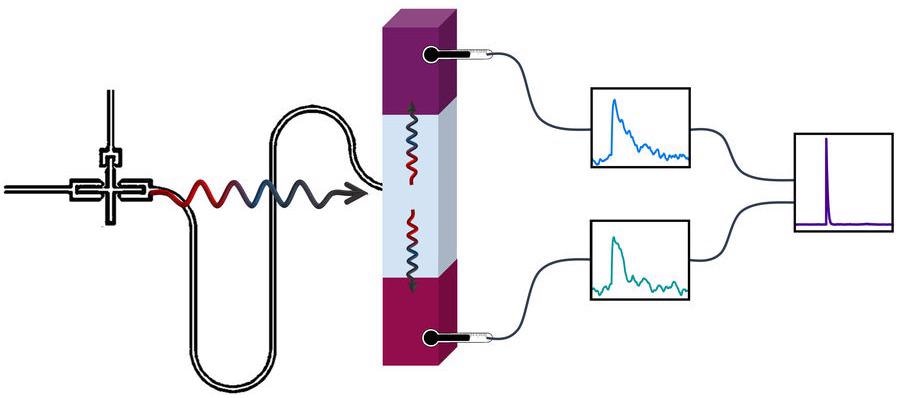A theoretical model displays how researchers can detect low-energy microwave photons discharged by superconducting qubits.
 A low energy photon emitted by a qubit can potentially be detected by measuring its energy with two thermometers simultaneously. The two signals are combined into a cross-correlation measurement with superior sensitivity. Image Credit: Bayan Karimi.
A low energy photon emitted by a qubit can potentially be detected by measuring its energy with two thermometers simultaneously. The two signals are combined into a cross-correlation measurement with superior sensitivity. Image Credit: Bayan Karimi.
Professor Jukka Pekola and Doctoral Candidate Bayan Karimi from Aalto University suggest a new method to quantify the energy of single microwave photons. Such low-energy quanta are discharged by artificial quantum systems like superconducting qubits.
Constant detection of superconducting qubits has been hard but would be beneficial in quantum information processing and other quantum technologies.
A photon is generated when a superconducting qubit transfers between states, radiating energy into its surrounding. Scientists capture the small energy of this photon by transferring it into heat.
The new method depends on splitting the energy of a photon throughout two separate heat baths and making measurements with the help of two uncoupled detectors at a time. This would considerably improve the signal-to-noise ratio, making it simpler to detect an absorption event and its energy.
In our proposed setup the energy of a qubit is large whereas its typical operating temperature is very low. This contrast opened an opportunity to solve the Schrödinger equation exactly for up to one million external oscillators forming the heat baths in the model describing this measurement.
Jukka Pekola, Professor, Aalto University
Karimi added, “Cross-correlation method can be used to measure extremely tiny temperature changes. It promises to detect energies several orders of magnitude smaller than in previously used methods.”
The scientists describe that several basic questions remain open but this would be the first time the energy of a photon has been divided into two various thermal detectors and noted. At present, the research group in the Pico group at Aalto University is executing experiments depending on this proposal.
Completing the experiment is extremely challenging, but success would be a dream come true.
Bayan Karimi, Doctoral Candidate, Aalto University
The scientists introduced the extremely sensitive calorimeter two years ago, and Physics World listed the calorimeter as one of the quantum highlights of 2020.
The research team is part of the Academy of Finland Centre of Excellence in Quantum Technology Finland (QTF), and InstituteQ, the Finnish Quantum Institute. Bayan Karimi worked in the Marie Curie training network QuESTech, and presently her research remains at the University of Helsinki, in close collaboration with the Aalto research group.
Journal Reference:
Pekola, J. P & Karimi, B (2022) Ultrasensitive Calorimetric Detection of Single Photons from Qubit Decay. Physical Review X. doi.org/10.1103/PhysRevX.12.011026